柠檬果实不同发育时期柠檬苦素及主要类黄酮分析
2018-03-13朱春华周先艳李进学杜玉霞董美超沈正松高俊燕潘思轶岳建强
朱春华,周先艳,李进学,杜玉霞,董美超,沈正松,高俊燕,潘思轶,岳建强
(1.云南省农业科学院热带亚热带经济作物研究所,云南保山 678600)(2.华中农业大学食品科学技术学院,湖北武汉 430000)
柠檬是芸香科柑橘属的常绿果树,在世界柑橘产业中,柠檬产量次于橙和宽皮橘,位居第三位。柠檬在大航海时代就用于治疗坏血症,不仅能够补充人体必需的维生素C,而且具有美容养颜、清除自由基、降尿酸、降血脂、降血压和防癌抗癌等功效[1~5]。柠檬果实中具有特殊功效的成分主要有圣草枸橼苷、柚皮苷、多甲氧基黄酮、D-柠檬烯、橙皮苷、地奥司明、香豆素及单萜物质橙皮油素类、柠檬醛和柠檬苦素类等物质[6]。
柠檬苦素类化合物是引起芸香科果实“后苦”的主要原因[7,8],存在于果实的不同部位[9],具有抗肿瘤[10]及白血病细胞[11]等功效。橙皮苷、地奥司明可抑制肿瘤细胞增殖,引起细胞凋亡[12,13]、具有降血压、降血脂等功效[14~16]、国外对柠檬、莱檬果实中黄酮物质含量及功效研究有较多报道[2,13,17,18],黄酮含量与品种[19,20]、果实不同部位[21]、成熟度、生长环境等因素有关[22~24]。于玉涵分析了四川安岳柠檬果实中 13种类黄酮含量[25],Wanpeng Xi报道了重庆5个柠檬品种不同部位的主要酚类物质及其抗氧化能力[26],王红静建立了尿酸模型,验证了云南柠檬具有降尿酸的功效[27],云南德宏和四川安岳是国内柠檬主产区,瑞丽柠檬是国家地理标志产品,柠檬鲜果较国内市场提前1~2月上市,作者曾分析了德宏地区柠檬不同发育时期基本营养品质的变化[28~30],但对云南柠檬果实中柠檬苦素、圣草枸橼苷、橙皮苷和地奥司明等具有特殊功效的功能成分未见报道。本文分析瑞丽三个不同生长发育时期的柠檬果实中柠檬苦素及主要类黄酮物质含量,可为柠檬深加工和健康饮食指导提供理论依据。
1 材料、方法
1.1 试验品种、气候条件
本文选择云南省德宏州瑞丽市勐秀乡勐典栽培的尤力克柠檬为研究对象,砧木为枳壳砧。种植地海拔950 mm,平均气温18.3~20 ℃,最高气温38.8 ℃,最低气温-2.1 ℃,1月份平均气温10.9 ℃~12.5 ℃,年均日照2218~2453 h,年均降雨量1400~1800 mm,年积温6400~7300 ℃。样品分析在中国农业科学院柑桔研究所农业部柑桔及苗木质量监督检验测试中心完成。
1.2 试验方法
1.2.1 标准品溶液的制备
准确称取圣草枸橼苷、芦丁、柚皮苷、橙皮苷、新橙皮苷、地奥司明、甜橙黄酮、川皮苷、橘黄酮和柠檬苦素各 5.00 mg,分别用色谱纯甲醇溶解并定容至10.00 mL容量瓶中,配成500 mg/L标准品的母液备用。采用逐级稀释法用色谱纯甲醇溶液将标准品溶液配制成一系列质量浓度的混合标准品溶液。
1.2.2 样品的制备
柠檬汁样品:新鲜柠檬洗净,采用手动压榨法制取新鲜柠檬汁,用双层纱布过滤后备用。准确吸取制好果汁样品2.00 mL置于50 mL离心管中,加入10.00 mL甲醇振荡1 min,以10000 r/min离心10 min,分离上清液,残渣以10 mL提取剂重复提取一次,合并上清液定容至25 mL,过0.22 μm微孔滤膜后待测。
1.2.3 色谱条件
色谱柱:ACQUITY UPLC BEH C1 8分析柱(2.1 mm×100 mm,1.7 μm);流动相:甲醇和0.2%乙酸溶液,采用梯度洗脱(见表1);柱温:35 ℃;流速:0.3 mL/min;定量波长为283 nm和330 nm,波长扫描范围200~400 nm,进样量为3.0 μL。以保留时间结合光谱扫描图定性,采用外标法定量。
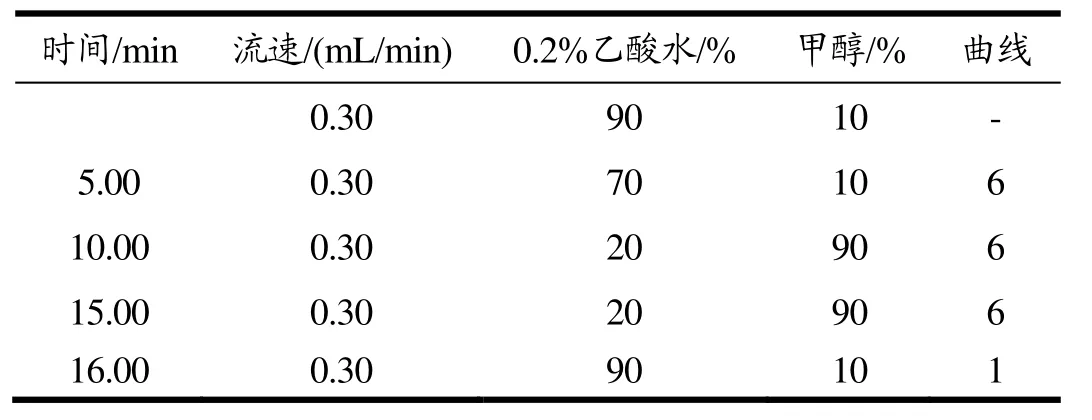
表1 流动相及流速Table 1 Mobile phase and flow rate
1.3 数据分析
数据分析采用SPASS 20.0,图形制作采用origin 8.0完成。
2 结果与分析
2.1 柠檬主要黄酮物质色谱图及含量

图1 类黄酮标准色谱图Fig.1 HPLC chromatogram of 9 flavonoids standards

图2 花后60 d柠檬果实类黄酮色谱图Fig.2 HPLC chromatogram of flavonoids in lemon fruit in 60 days
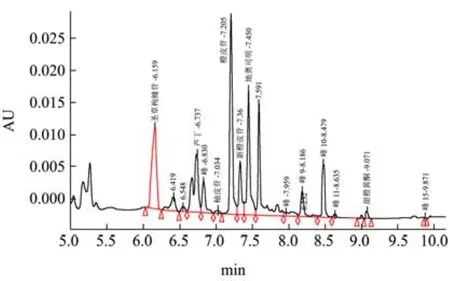
图3 花后150 d柠檬果实类黄酮色谱图Fig.3 HPLC chromatograms of flavonoids in 150 days
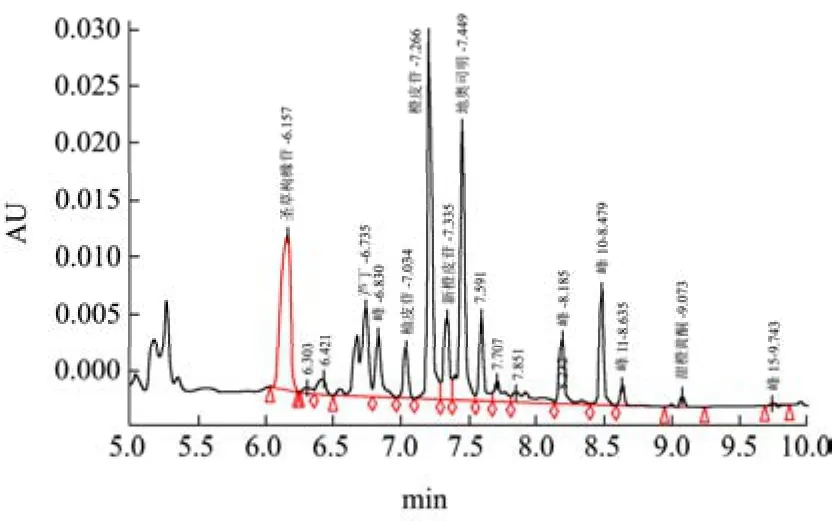
图4 花后210 d柠檬果实类黄酮色谱图Fig.4 HPLC chromatogram of flavonoids in lemon fruit in 210 days

图5 柠檬苦素标准色谱图Fig.5 HPLC chromatogram of limonin standard
柠檬果实中类黄酮混合标准品的HPLC色谱图见图1。混合标准品中各类黄酮成分目标峰形尖锐,对称性好。
柠檬果实中主要类黄酮成分含量结果见表2,由表中可见,不同发育时期柠檬果实中类黄酮种类和含量差异显著。随着柠檬果实的成熟,类黄酮含量总体呈下降趋势,花后60 d总含量为83.15 mg/g,花后210 d下降至20.94 mg/g。柠檬果实中地奥司明含量最高,含量占总类黄酮含量的83.26%~84.61%、其次为黄烷酮类,占14.18%~15.45%,含量最低的为多甲氧基黄酮,含量仅为0.01%~0.89%。4种黄烷酮在不同发育时期均达到极显著水平(p<0.01),橙皮苷、新橙皮苷随着果实的成熟,含量呈下降趋势,从花后60 d至花后210 d,分别下降了85.74%和76.11%;圣草枸橼苷、柚皮苷则与之相反,随着成熟度的增加,其含量增多,圣草枸橼苷从0.02 mg/g增加至0.98 mg/g;柚皮苷在花后60 d未检出,花后210 d含量为0.01 mg/g。
在柑橘中,柚皮素及产物在7-O-葡萄糖苷转移酶的作用下先形成7-O-葡萄糖苷类,经1,2-鼠李糖基转移酶催化形成带苦味的柚皮苷、新橙皮苷、新圣草次苷和枳属苷,然后在1,6-鼠李糖基转移酶的作用下分别形成无苦味的柚皮芸香苷、橙皮苷、圣草次苷和香风草苷[31,32]。本实验中,新橙皮苷在花后150 d、210 d分别下降了75.6%、76.14%,圣草枸橼苷在花后150 d、210 d分别增加了61.1%、64.2%,推测可能是新橙皮苷转化为圣草枸橼苷。
芦丁在不同果实发育时期均达到了极显著水平(p<0.01),含量随着果实的成熟逐渐降低,花后60 d含量为1.31 mg/g,花后210 d下降至0.25 mg/g,降幅为81.02%。地奥司明是柠檬果实中含量最高的黄酮类物质,花后60 d含量为69.69 mg/g,占总类黄酮含量的83.81%,花后150 d降至14.91 mg/g,但仍是同一时期含量最高的物质,发育至花后210 d,含量为17.72 mg/g,占总类黄酮含量的84.61%。柠檬果实中未检测出橘黄酮,甜橙黄酮和川皮苷均呈现先升后降的趋势,花后150 d均达到最高值,二者均为0.01 mg/g。甜橙黄酮含量在不同时期达到了极显著水平(p<0.01),花后60 d未检出,花后150 d增至0.01 mg/g,花后210 d降低至0.001 mg/g,川皮苷未达到显著水平。
本文中除了圣草枸橼苷、柚皮苷在果实发育过程中含量呈上升趋势,柠檬苦素、地奥司明和橙皮苷等物质伴随果实的发育和成熟其含量总体呈现下降的趋势,这与Kim等人研究结果相似[33,34],J Chen等也表明4种甜橙中尽管黄烷酮在果实的绿熟期和转色期其积累量有少许波动,但黄烷酮糖苷类在不同种质果实的不同组织中都呈现总体下降的趋势[12],说明黄酮类在柑橘果实中的代谢存在明显的规律性变化,但柠檬果实中黄酮物质具体代谢途径有待进一步研究。
J Chen表明,橘、甜橙和柠檬中无苦味的芸香糖苷类尤其是橙皮苷异常丰富[35],Delourdesmatabilbao指出芦丁是柑橘中含量最为丰富的黄酮醇糖苷,且以柠檬中的含量居高[36],Escriche等也指出黄酮醇则主要存在于柠檬中[37],于玉涵表明四川尤力克柠檬果实中含量最高的类黄酮物质为橙皮苷和圣草枸橼苷[16],Wanpeng Xi也报道了四川柠檬果实中橙皮苷是主要的黄酮类物质[17],Vincenzo Sicari指出意大利卡拉布里亚区柠檬果实中新橙皮苷含量最高、柚皮苷次之[16]。本文检测结果表明,在整个柠檬果实发育过程中,地奥司明含量最高,其次为橙皮苷和新橙皮苷为主的黄烷酮类,含量最低的为多甲氧基黄酮,但未检出橘黄酮,芦丁为代表的黄酮醇类物质含量在柠檬果实中并不高,该结果与现有文献的差异可能由于地理气候、土壤条件有关,推测云南德宏气候条件下更有利于地奥司明成分积累,具体原因有待进一步研究。
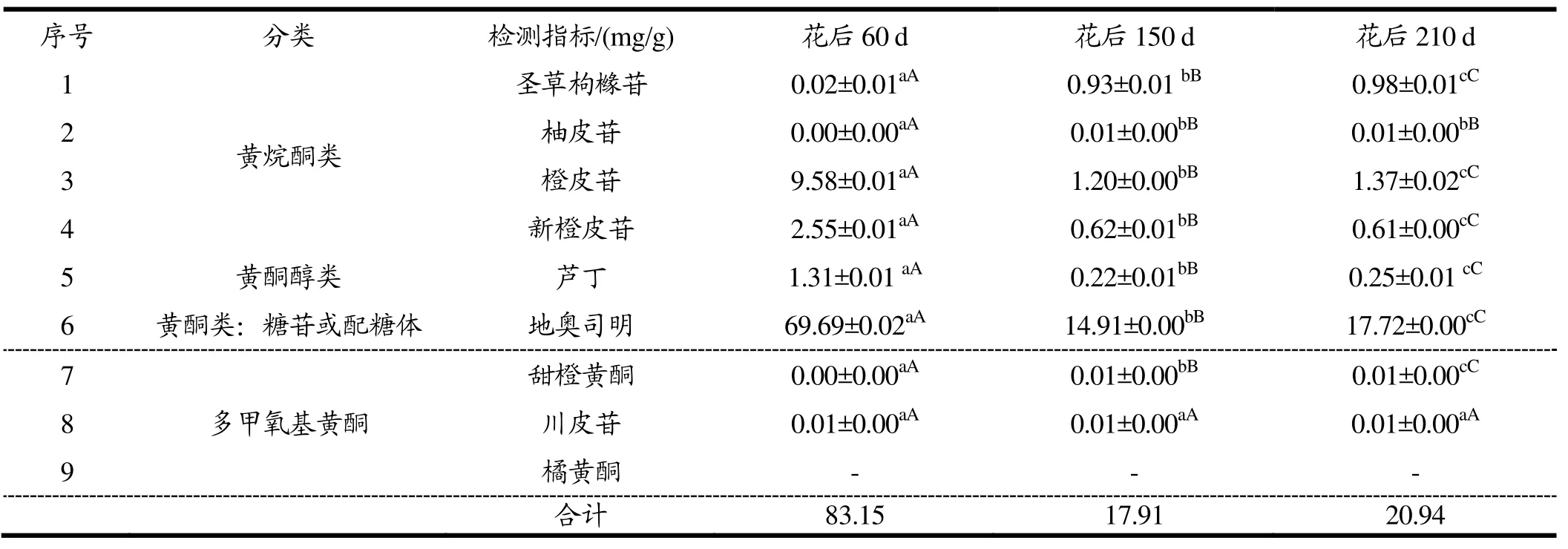
表2 柠檬果实中主要功能成分含量Table 2 The content of main functional components in lemon fruit
2.2 柠檬苦素色谱图及含量分析
三个不同时期的柠檬果实中均检测到柠檬苦素,含量随着果实的成熟而逐渐降低,如图5所示。柠檬苦素在柠檬果实中含量见图 9,柠檬苦素在果实发育过程中呈下降趋势,含量差异达到显著水平(p<0.05),花后60 d含量为0.11 mg/g,花后150 d下降至0.05 mg/g,花后210 d含量最低,仅为0.04 mg/g。

图6 花后60d柠檬果实柠檬苦素色谱图Fig.6 HPLC chromatogram of limonin in lemon fruit in 60 days
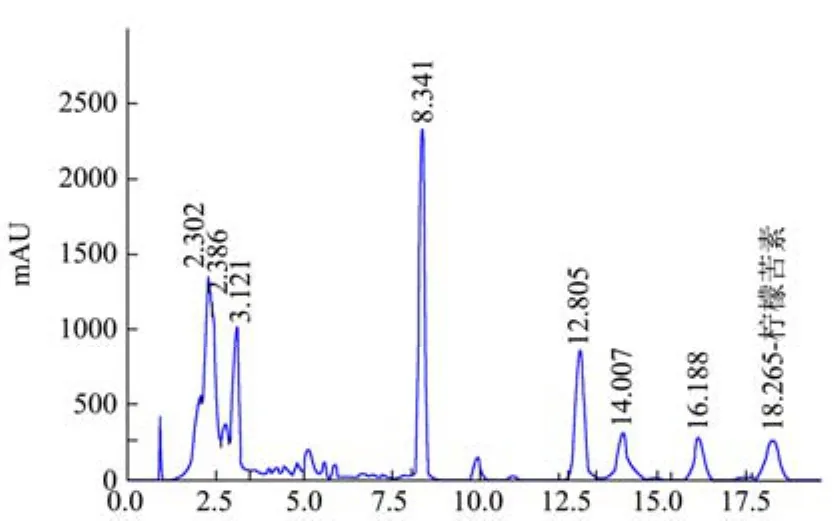
图7 花后150d柠檬果实柠檬苦素色谱图Fig.7 HPLC chromatogram of limonin in lemon fruit in 150 days
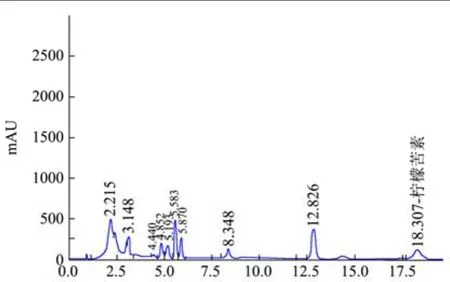
图8 花后210d柠檬果实柠檬苦素色谱图Fig.8 HPLC chromatogram of flavonoids in lemon fruit in 210 days
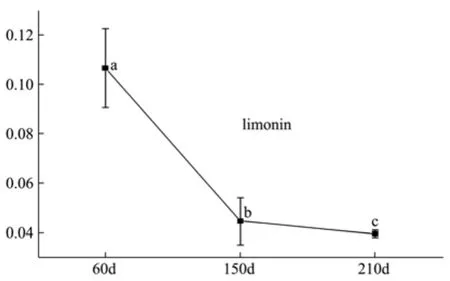
图9 不同时期柠檬苦素含量变化图Fig.9 Limonin content in lemon fruit at different mature stages
根据人口感柠檬苦素阈值在6 mg/L以下,花后210 d时仍有较明显的苦味。今后应完善和深入其在代谢及调控方面的研究,为高效提升柠檬果实特殊功效成分调控提供便捷之径,并为果实品质的提升提供理论依据。
3 结论
本文研究表明,在柠檬果实发育过程中,类黄酮含量总体呈下降趋势,花后60 d总含量为83.15 mg/g,花后210 d下降至20.94 mg/g。柠檬果实中含有大量类黄酮,尤其是地奥司明和橙皮苷,地奥司明含量占总类黄酮含量的83.26%~84.61%,其次为黄烷酮类(橙皮苷和新橙皮苷为主),占14.18%~15.45%,含量最低的为多甲氧基黄酮,含量仅为0.01%~0.89%,未检测出橘黄酮。除了川皮苷,其余物质均达到极显著水平(p<0.01)。花后 210 d时,柠檬苦素含量仍为 0.04 mg/g,有较明显的苦味。
[1]Ali Hassan, Rizk Basili. The antiscorbutic value of fresh lime juice [J]. Biochemical Journal, 1932, 26(6): 1846-1850
[2]Z Adibelli, M Dilek, T Akpolat. Lemon juice as an alternative therapy in hypertension in Turkey [J]. International Journal of Cardiology, 2009, 135(2): 58-59
[3]D Barreca, E Bellocco, C Caristi, et al. Flavonoid profile and radical-scavenging activity of Mediterranean sweet lemon(Citrus limetta Risso) juice [J]. Food Chemistry, 2011, 129(2):417-422
[4]Y Miyake, E Suzuki, S Ohya, et al. Lipid-lowering effect of eriocitrin, the main flavonoid in lemon fruit, in rats on a high-fat and high-cholesterol diet [J]. Journal of Food Science,2006, 71(9): S633-S637
[5]B Aras, N Kalfazade, V Tugcu, et al. Can lemon juice be an alternative to potassium citrate in the treatment of urinary calcium stones in patients with hypocitraturia? [J]. A Prospective Randomized Study, Urol Res, 2008, 73(3):313-317
[6]马兆成,朱春华.柠檬与生活[M].北京:中国农业出版社,2016 MA Zhao-cheng, ZHU Chun-hua. Lemon and life [M].Beijing: Chinese Agriculture Press, 2016
[7]H Ni, S F Zhang, Q F Gao, et al. Development and evaluation of simultaneous quantification of naringin, prunin, naringenin,and limonin in citrus juice [J]. Food Science and Biotechnology, 2015, 24: 1239-1247
[8]F Wang, X Yu, X Liu, et al.Temporal and spatial variations on accumulation of nomilin and limonin in the pummelos [J].Plant Physiol Biochem, 2016, 106: 23-29
[9]H Yu, C Wang, S Deng, et al. Optimization of ultrasonic-assisted extraction and UPLC-TOF/MS analysis of limonoids from lemon seed [J]. LWT - Food Science and Technology, 2017, 84 : 135-142
[10]K N Chidambara Murthy, G K Jayaprakasha, B S Patil.Citrus limonoids and curcumin additively inhibit human colon cancer cells [J]. Food Funct, 2013, 4(5): 803-810
[11]M Z El-Readi, D Hamdan, N Farrag, et al. Inhibition of P-glycoprotein activity by limonin and other secondary metabolites from Citrus species in human colon and leukaemia cell lines [J]. European Journal of Pharmacology,2010, 626(2-3): 139-145
[12]J Chen, S Li, J Xu, et al. Concentration and distribution of main bitter compounds in fruit tissues of ‘Oroblanco’ (Citrus grandis L.×Citrus paradisi Macf.) [J]. Scientia Horticulturae,2015, 193: 84-89
[13]JA Del Río, M D Fuster, P Gómez, et al. Citrus limon: a source of flavonoids of pharmaceutical interest [J]. Food Chemistry, 2004, 84(3): 457-461
[14]C Morand, C Dubray, D Milenkovic, et al. Hesperidin contributes to the vascular protective effects of orange juice: a randomized crossover study in healthy volunteers [J]. The American Journal of Clinical Nutrition, 2011, 93: 73-80
[15]T Silambarasan, B Raja. Diosmin, a bioflavonoid reverses alterations in blood pressure, nitric oxide, lipid peroxides and antioxidant status in DOCA-salt induced hypertensive rats [J].European Journal of Pharmacology, 2012, 679: 81-89
[16]V Habauzit, S M Sacco, A Gil-Izquierdo, et al. Differential effects of two citrus flavanones on bone quality in senescent male rats in relation to their bioavailability and metabolism[J]. Bone, 2011, 49: 1108-1116
[17]S Srinivasan, L Pari. Antihyperlipidemic effect of diosmin: A citrus flavonoid on lipid metabolism in experimental diabetic rats [J]. Journal of Functional Foods, 2013, 5: 484-492
[18]A Girones-Vilaplana, D A Moreno, C Garcia-Viguera.Phytochemistry and biological activity of Spanish Citrus fruits [J]. Food Funct, 2014, 5(4): 764-772
[19]M S Tounsi, W A Wannes, I Ouerghemmi, et al. Juice components and antioxidant capacity of four Tunisian Citrus varieties [J]. J Sci. Food Agric., 2011, 91: 142-151
[20]R Guimaraes, L Barros, J C Barreira, et al. Targeting excessive free radicals with peels and juices of citrus fruits:grapefruit, lemon, lime and orange [J]. Food Chem Toxicol,2010, 48: 99-106
[21]Y-C Wang, Y-C Chuang, H-W Hsu. The flavonoid,carotenoid and pectin content in peels of citrus cultivated in Taiwan [J]. Food Chemistry, 2008, 106: 277-284
[22]V Sicari, T M Pellicanò, A M Giuffrè, et al. Bioactive compounds and antioxidant activity of citrus juices produced from varieties cultivated in Calabria [J]. Journal of Food Measurement and Characterization, 2016, 10(4): 773-780
[23]M A Anagnostopoulou, P Kefalas. Bioflavonoid profile of citrus juices from Greece [J]. Biomed Chromatogr, 2012,26(10): 1252-1268
[24]Corrado Caristi, Ersilia Bellocco, Vincenza Panzera, et al.Flavonoids Detection by HPLC-DAD-MS-MS in Lemon Juices from Sicilian Cultivars [J]. J. Agric. Food Chem., 2003,51(12): 3528-3534
[25]于玉涵.柠檬中黄酮类化合物和辛弗林的检测和含量特征分析[D].重庆:西南大学,2011 YU Yu-han. Determination andquantitation of flavonoids and synephrine in Lemon Fruits [D]. Chongqing: Southwestern University, 2011
[26]W Xi, J Lu, J Qun, et al. Characterization of phenolic profile and antioxidant capacity of different fruit part from lemon(Citrus limon Burm.) cultivars [J]. J Food Sci Technol., 2017,54(5): 1108-1118
[27]王红静.柠檬降尿酸效果研究[D].武汉:华中农业大学,2016 WANG Hong-jing. Research on uric acid reducing effect of lemon [D]. Wuhan: Huazhong Agricultural University, 2016
[28]朱春华,高俊燕,李进学,等.柠檬和莱檬果皮精油挥发性成分分析[J].天然产物研究与开发,2012,24(11):1565-1570 ZHU Chun-hua, GAO Jun-yan, LI Jin-xue, et al. Volatile components analysis of the peel of lemon and lime species [J].Natural Product Research and Development, 2012, 24(11):1565-1570
[29]朱春华,李进学,高俊燕,等.柠檬秋花果实发育及成熟品质变化特征研究[J].湖南农业科学,2011,19:115-118 ZHU Chun-hua, LI Jin-xue, GAO Jun-yan, et al. Quality changing characteristics of off-season lemon fruit in development and mature period [J]. Hunan Agricultural Sciences, 2011, 19: 115-118
[30]朱春华,李进学,高俊燕,等.GC-MS分析柠檬不同品种果皮精油成分[J].现代食品科技, 2012,28(9):1223-1227 ZHU Chun-hua, LI Jin-xue, GAO Jun-yan, et al. Analysis of volatile components of the peel of different lemon cultivars[J]. Modern Food Science and Technology, 2012, 28(9):1223-1227
[31]E Lewinsohn, Y Mazur, J Gressel. Flavanone glycoside biosynthesis in citrus chalcone synthase,UDP-glucose:flavanone-7-O-glucosyl-transferase and rhamnosyltransferase activities in cell-Free extracts [J]. Plant Physiology, 1989, 91(4): 1323-1328
[32]A Frydman, R Liberman, D V Huhman, et al. The molecular and enzymatic basis of bitter/non-bitter flavor of citrus fruit:evolution of branch-forming rhamnosyltransferases under domestication [J]. Plant J, 2013, 73: 166-178
[33]H G Kim, G S Kim, J H Lee, et al. Determination of the change of flavonoid components as the defence materials of Citrus unshiu Marc. fruit peel against Penicillium digitatum by liquid chromatography coupled with tandem mass spectrometry [J]. Food Chem., 2011, 128: 49-54
[34]P L Li, M H Liu, J H Hu, et al. Systematic chemical profiling of Citrus grandis 'Tomentosa' by ultra-fast liquid chromatography/diode-array detector/quadrupole time-offlight tandem mass spectrometry [J]. J Pharm. Biomed. Anal.,2014, 90: 167-179
[35]J Chen, H Zhang, Y Pang, et al. Comparative study of flavonoid production in lycopene-accumulated and blonde-flesh sweet oranges (Citrus sinensis) during fruit development [J]. Food Chem., 2015, 184: 238-246
[36]M Delourdesmatabilbao, C Andreslacueva, O Jauregui, et al.Determination of flavonoids in a Citrus fruit extract by LC-DAD and LC-MS [J]. Food Chemistry, 2007, 101:1742-1747
[37]I Escriche, M Kadar, M Juan-Borras, et al. Using flavonoids,phenolic compounds and headspace volatile profile for botanical authentication of lemon and orange honeys [J].Food Research International, 2011, 44(5): 1504-1513
